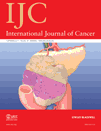Cancer registration and healthcare access in West Bank, Palestine: A GIS analysis of childhood cancer, 1998–2007
Abstract
In low and middle income countries (LMIC), high-quality disease registration is difficult to achieve in the setting of inadequate healthcare infrastructure and political or economical instability. In this article, we explore the potential of geographic information systems (GIS) to add value to the understanding of childhood cancer patterns in the West Bank, despite a variety of obstacles to disease registration. All incidence cases of childhood cancers (under the age 15) from 1998 to 2007 were collected from the West Bank Cancer Registry. Temporal, spatial and space–time analyses were performed using the SatScan software developed by Martin Kulldorff and the National Cancer Institute (NCI). The analyses were categorized into the following groups: all childhood cancer, leukemias, acute lymphocytic leukemia, lymphomas, brain and central nervous system (CNS) cancers and remaining cancers (excluding leukemia, lymphoma and CNS tumors). The temporal analysis revealed that cancer registration was more complete from 1998 to 2000 (p = 0.0162), and that leukemia registration was severely deficient from 2003 to 2005 (p = 0.0012). The spatial analysis showed a concentration of cancer in metropolitan districts where referral hospitals are based. Under registration was detected in the northern districts of Jenin and Tulkarm (RR = 0.59, p = 0.0059), more prominent from 2002 to 2005 (RR = 0.33, p = 0.0006). The analysis for high rates found a cluster of lymphoma in town of Dura and its surrounding agricultural villages (RR = 4.10, p = 0.0023). Our study reveals that the application of GIS tools to registry data in LMIC can help to identify geographical patterns in cancer registration and healthcare accessibility, generating priorities for future health research and policy in resource-limited areas.




